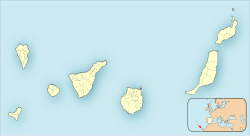Güímar
| Güímar | |||
|---|---|---|---|
| Municipality | |||

Pyramid of Güímar
|
|||
|
|||
| Location in Canary Islands, off the western coast of Africa | |||
| Coordinates: 28°18′54″N 16°24′36″W / 28.31500°N 16.41000°WCoordinates: 28°18′54″N 16°24′36″W / 28.31500°N 16.41000°W | |||
| Country |
|
||
| Autonomous Community |
|
||
| Province | Tenerife | ||
| Island | Tenerife | ||
| Government | |||
| • Mayor | Carmen Luisa Castro Dorta (PP) | ||
| Area | |||
| • Total | 102.9 km2 (39.7 sq mi) | ||
| Elevation(AMSL) | 289 m (948 ft) | ||
| Population (2015) | |||
| • Total | 19,006 | ||
| • Density | 180/km2 (480/sq mi) | ||
| Time zone | CET (UTC+0) | ||
| • Summer (DST) | CEST (GMT +1) (UTC+1) | ||
| Postal code | 38500 | ||
| Area code(s) | +34 (Spain) + 922 (Tenerife) | ||
| Climate | BSh | ||
| Website | www.guimar.es | ||
Güímar (Spanish pronunciation: [ˈgwimar]) is the name of a municipality, town, and valley in the eastern part of the Spanish island of Tenerife, one of the Canary Islands, and part of Santa Cruz de Tenerife (province). The municipality and extends for 1,029 square kilometers from the mountainous interior to the beaches on the Atlantic, and borders the municipalities of La Orotava, Arafo, and Fasnia. Its estimated population is 18,589 (2013). The TF-1 motorway passes through the municipality.
The municipality is famous for its Guanche pyramids. It is also the location of the barranco de Badajoz. A portion of its volcanic landscape has been set aside as the Nature reserve of Malpaís of Güímar, its highest point being Montaña Grande.
...
Wikipedia



